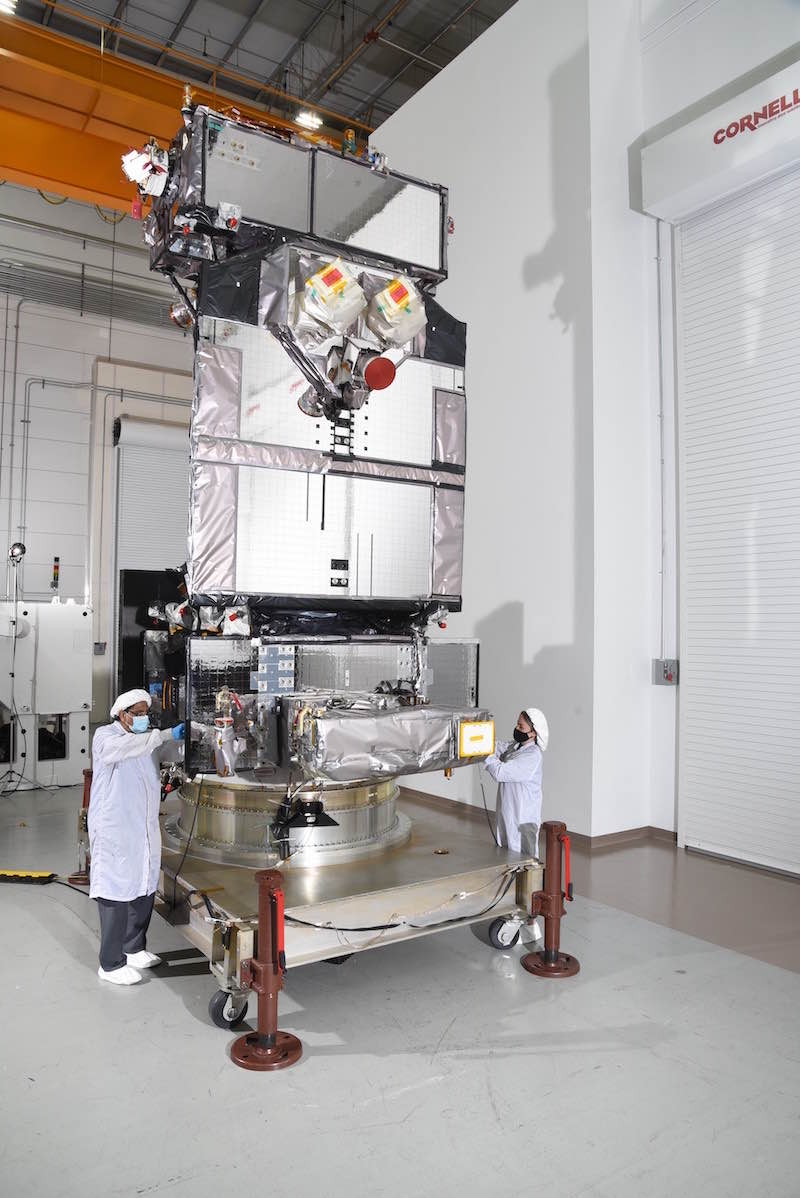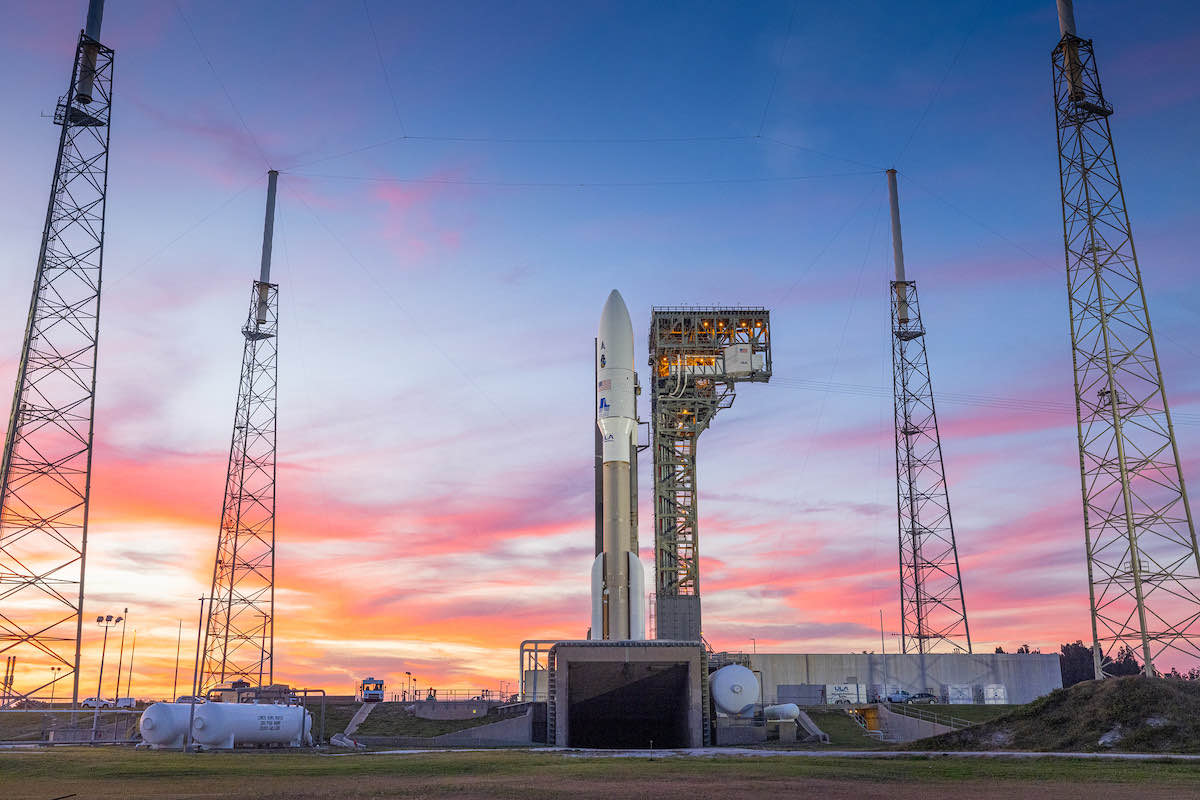A $320 million NASA experiment to test high-speed laser communications links between Earth and space is poised for launch Tuesday, tagging along for a ride to geosynchronous orbit on a US Space Force mission aboard a United Launch Alliance Atlas 5 rocket.
The NASA tech demo experiment is attached to the Space Force’s STPSat 6 satellite, the primary payload on an Atlas 5 rocket set for liftoff from Cape Canaveral during a two-hour launch window opening at 4:04 a.m. EST (0904 GMT) Tuesday.
The launch was previously scheduled for Sunday, but a leak in the launch pad’s kerosene fuel storage system forced a two-day delay.
NASA’s Laser Communications Relay Demonstration, or LCRD mission, is embarking on a two-year series of experiments to test how optical communications links could help downlink large volumes of information faster than traditional radio-based communications systems.
“We have been working on this technology project for a while now, and we are more than ready to see this capability go to its demonstration phase,” said Trudy Kortes, director of technology demonstrations in NASA’s space technology mission directorate. “The objective of this demonstration is to prove out NASA’s first bi-directional end-to-end test of a communication system that can transmit data at a rate of 10 to 100 times faster than our current radio frequency baseline systems. And with an optical downlink to transmit data back to us using lasers, this truly is a first of its kind demonstration.”
Future data-hungry space missions, such as NASA’s Artemis missions to the moon and future Mars expeditions, will likely need laser communications links to transmit data back to Earth. NASA could also user lasers to uplink larger data packages to astronauts on the moon.
“As missions generate and collect more data, higher bandwidth is needed to relay data back to us, and that’s exactly what LCRD is testing and demonstrating,” Kortes said. “This new system will not only provide higher data transmission rates … It’ll be smaller in volume, way less and use less power than current state of the art. And as we work to establish a robust presence on the moon and ultimately send humans to Mars, tech demos like LCRD are absolutely critical to enabling our future mission needs.”
The laser experiment will break new ground in optical communications, according to NASA.
Some networks use laser links to beam data between satellites in space. SpaceX’s Starlink internet network uses laser cross-links to allow internet traffic to leap from spacecraft to spacecraft, and the European Space Agency’s data relay system uses a similar optical communications architecture to collect imagery from Europe’s Copernicus environmental monitoring satellites.
But the Starlink and European Data Relay System networks use conventional radio signals to return data to Earth.
“There’s a ton of commercial activity for space-to-space links in optical, and that’s great because that drives cost down, increases availability, makes sure that lots of folks are able to access and use them,” said Jason Mitchell, director of NASA’s advanced communications and navigation technology division. “But from our perspective, one of the challenges is that direct Earth link. The atmosphere, depending on where you’re at, can really impact the laser channel. Turbulence can sort of distort the beam.”
Satellite communications using radio frequencies can get around some atmospheric interference by increasing power. Some radio bands are also less susceptible to blockage by clouds and rain.
“There’s a certain point that that we can’t turn up the power and get past the bad weather like you can on an RF (radio frequency) link,” said Dave Israel, principal investigator for the LCRD mission at NASA’s Goddard Space Flight Center. “You have to steer your laser beam someplace else. So we need to get a lot of operational experience before we’re able to use optical communications for our our missions.”

NASA has set up two ground sites in Hawaii and California to link up with the LCRD payload in space. Engineers are testing one-meter optical telescopes at both locations, which are positioned at high altitude to minimize cloud cover and other atmospheric effects on the laser link.
Part of the LCRD experiment will involve collecting weather data at the Hawaii and California ground stations, according to Miriam Wennersten, ground segment manager on the LCRD mission at Goddard. Engineers will study how different weather conditions impact the laser communications link.
“Lasers can be blocked by clouds, which is why site diversity is important,” Mitchell said.
The LCRD payload on STPSat 6 consists of two optical communication terminals and a switching unit, allowing the instrument to receive a signal, transition the data to a transmitter, then beam the signal to its destination.
LCRD works with infrared lasers, which aren’t visible to the human eye. Laser wavelengths are 10,000 times shorter than radio waves, meaning data can travel in narrower beams.
Lasers are still constrained by the laws of physics, and travel at the speed of light.
“When we say faster, it has to do in terms of being able to dump large amount of data all at once, instead of having to take time to downlink the data to the ground,” said Badri Younes, deputy associate administrator for NASA’s space communications and navigation program.
LCRD’s initial experiments will pass data back and forth between the mission’s ground stations. Next year, NASA plans to launch a laser communications terminal to the International Space Station on a commercial cargo ship, allowing LCRD to test out an optical link with a moving object speeding around Earth at 5 miles per second.
The laser terminals on the tech demo experiment will downlink data at a rate of 1.2 gigabits per second. The system is capable of a similar uplink rate from the the space station.
STPSat 6, the satellite hosting the LCRD payload, will be positioned in geosynchronous orbit more than 22,000 miles (nearly 36,000 kilometers) over the equator. The orbit will give STPSat 6, and its NASA-funded laser experiment, a continuous view of the Americas and the Pacific Ocean.
Israel, the experiment’s lead scientist, said NASA plans to test out different “user cases” throughout LCRD’s two-year primary mission. The testing will allow NASA to learn how optical communications will work in the context of a larger network. The test data will include spacecraft health telemetry, tracking and command data, and sample user data, according to NASA.
NASA previously demonstrated direct-to-Earth optical communications from a spacecraft orbiting the moon in 2013 and 2014. But the testing time on that experiment was limited because the laser payload was a secondary objective on the mission.
“This is really that operational demonstration,” Israel said. “So the two years on orbit will give us a lot of time to do a wide variety of experiments and gather a lot of data and refine our models.”
NASA is also opening up the laser communications experiment to other organizations, Israel said. But the LCRD payload, which was developed before the deployment of the Starlink network, is not compatible with the laser terminals on SpaceX’s internet fleet.
The LCRD experiment is led by NASA’s Goddard Space Flight Center with support from the Jet Propulsion Laboratory and MIT Lincoln Laboratory.

NASA’s LCRD payload is one of nine hosted payloads mounted on the STPSat 6 spacecraft, which was built by Northrop Grumman for the military’s Space Test Program, which oversees many of the Defense Department’s experimental space missions.
The launch itself is designated STP-3.
STPSat 6 also has a payload for the National Nuclear Security Administration designed to detect nuclear detonations to verify international treaty compliance. The military hasn’t disclosed details for other experiments on the mission, but officials said they generally will test technologies related to space domain awareness, space weather monitoring, and communications.
Military engineers will test their readiness for use on future operational space missions.
A smaller rideshare satellite named the Long Duration Propulsive ESPA, or LDPE 1, also is riding to orbit on the Atlas 5 rocket. It is mounted to the rocket below STPSat 6 inside the 17.7-foot (5.4-meter) diameter payload fairing.
LDPE 1 hosts its own technological experiments, and will have its own propulsion system to maneuver in space.
Once STPSat 6 is in orbit, ground teams will complete checkouts of the spacecraft in the next few weeks, then begin activating the satellite’s payloads. Mitchell said the LCRD experiment should be ready to begin its experiments in February.
The LCRD experiment was originally supposed to launch on a commercial communications spacecraft in 2016, but NASA switched the payload to a Space Force satellite. Delays with the STPSat 6 spacecraft delayed the launch until mid-2021, and then the mission slipped to the end of the year after a reshuffling of the Atlas 5 launch schedule.
The Space Force passed up a launch opportunity in June as ULA investigated unexpected behavior of an upper stage engine on a previous Atlas 5 rocket. Delays on a planned launch of Boeing’s Starliner crew capsule on a test flight to the space station prevented the STP-3 mission from launching in September, then the launch of NASA’s Lucy asteroid explorer in October took priority on the Atlas 5 schedule.
Assuming the laser terminals are working well, NASA could transition the LCRD payload to operational use after the two-year primary mission.
“Beyond the demonstration, we may look at applying it here and there to provide some support int he near-Earth environment,” Younes said.
Eventually, lessons learned from the laser communications experiment will be turned over to private industry. NASA has launched a series of tracking and data relay satellites since the 1980s using radio frequencies to bridge data between mission control space shuttles and the space station. NASA isn’t planning to build and launch any more government-owned data relay satellites.
“NASA has decided to commercialize much of its near-Earth communication capability, acquiring communication services from the private sector. We are pursuing an environment where our users can roam in space and can get support from any provider that’s out there,” Younes said.
Optical signals are not regulated by international or federal agencies.
“Access to the (radio) spectrum is so heavily burdened by regulations, but not the optical domain,” Younes said. “The optical domain will provide a common channel for all to communicate and be able to provide support for each other. This is so critical for us. That’s why we are going to push the technology as far as we can. But first we have to gain experience with it.”
Email the author.
Follow Stephen Clark on Twitter: @StephenClark1.